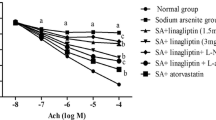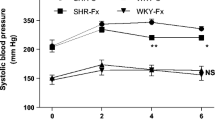Abstract
The present study has been designed to investigate the effect of benfotiamine, a thiamine derivative, in sodium arsenite-induced vascular endothelial dysfunction (VED) in rats. Sodium arsenite (1.5 mg−1 kg−1 day−1 i.p., 2 weeks) was administered in rats to produce VED. The development of VED was assessed by employing isolated aortic ring preparation and estimating the serum and aortic concentrations of nitrite/nitrate. Further, the integrity of vascular endothelium in thoracic aorta was assessed by scanning electron microscopy. Moreover, the oxidative stress was assessed by estimating serum thiobarbituric acid reactive substances (TBARS) and aortic superoxide anion generation. The administration of sodium arsenite markedly produced VED by attenuating acetylcholine-induced endothelium-dependent relaxation, decreasing serum and aortic concentrations of nitrite/nitrate, and impairing the integrity of vascular endothelium. Further, sodium arsenite produced oxidative stress by increasing serum TBARS and aortic superoxide generation. The treatment with benfotiamine (25, 50, and 100 mg−1 kg−1 day−1 p.o.) or atorvastatin (30 mg−1 kg−1 day−1 p.o., a standard agent) prevented sodium arsenite-induced VED and oxidative stress. However, the beneficial effects of benfotiamine in preventing the sodium arsenite-induced VED were attenuated by co-administration with N-omega-nitro-l-arginine methyl ester (L-NAME) (25 mg−1 kg−1 day−1, i.p.), an inhibitor of NOS. Thus, it may be concluded that benfotiamine reduces oxidative stress and activates endothelial nitric oxide synthase to enhance the generation and bioavailability of NO and subsequently improves the integrity of vascular endothelium to prevent sodium arsenite-induced experimental VED.







Similar content being viewed by others
References
Le Brocq M, Leslie JS, Milliken P, Megson IL (2008) Endothelial dysfunction: from molecular mechanism to measurements, clinical implications and therapeutic opportunities. Antioxid Redox Signal 10:1631–1674
Esper RJ, Nordaby RA, Vilarino JO, Paragano A, Cacharron JL, Machado RA (2006) Endothelial dysfunction: a comprehensive appraisal. Cardiovasc Diabetol 5:4
Balakumar P, Jindal S, Shah DI, Singh M (2007) Experimental models for vascular endothelial dysfunction. Trends Med Res 2:12–20
Furchgott RF, Zawadzki JV (1980) The obligatory role of endothelial cells in the relaxation of arterial smooth muscle by acetylcholine. Nature 288:373–376
Ignarro LJ (1989) Endothelium-derived nitric oxide, actions and properties. FASEB J 3:31–36
Balakumar P, Kaur T, Singh M (2008) Potential target sites to modulate vascular endothelial dysfunction: current perspectives and future directions. Toxicology 245:49–64
Desjardins F, Balligand JL (2006) Nitric oxide-dependent endothelial function and cardiovascular disease. Acta Clin Belg 61:326–334
Bonetti PO, Lerman LO, Lerman A (2003) Endothelial dysfunction: a marker of atherosclerotic risk. Arterioscler Thromb Vasc Bio 23:168–175
Balakumar P, Koladiya RU, Ramasamy S, Rathinavel A, Singh M (2008) Pharmacological interventions to prevent vascular endothelial dysfunction: future directions. J Health Sci 54:1–16
Yang Z, Ming XF (2006) Recent advances in understanding endothelial dysfunction in atherosclerosis. Clin Med Res 4:53–56
Giansante C, Fiotti N (2006) Insights into human hypertension: the role of endothelial dysfunction. J Human Hypertens 20:725–726
Heitzer T, Schlinzig T, Krohn K, Meinertz T, Munzel M (2001) Endothelial dysfunction, oxidative stress and risk of cardiovascular events in patients with coronary artery disease. Circulation 104:2673–2678
Engel RR, Rich CH, Receveur O, Smith AH (1994) Vascular effects of chronic arsenic exposure: a review. Epidemiol Rev 16:184–209
Wu MM, Chiou HY, Ho IC, Chen CJ, Lee TC (2003) Gene expression of inflammatory molecules in circulating lymphocytes from arsenic-exposed human subjects. Environ Health Perspect 111:1429–1438
Barchowsky A, Roussel RR, Klei LR, James PE, Ganju N, Smith KR et al (1999) Low levels of arsenic trioxide stimulate proliferative signals in primary vascular cells without activating stress effector pathways. Toxicol Appl Pharmacol 159:65–75
Bunderson M, Coffin JD, Beall HD (2004) Arsenic exposure exacerbates atherosclerotic plaque formation and increases nitrotyrosine and leukotriene biosynthesis. Toxicol Appl Pharmacol 201:32–39
Tsou TC, Tsai FY, Hsieh YW, Li LA, Yen SC, Chang LW (2005) Arsenic induces cytotoxicity by down-regulation of vascular endothelial nitric oxide synthase. Toxicol Appl Pharmacol 208:277–284
Lynn S, Gurr JR, Lai HT, Jan KY (2000) NADH oxidase activation is involved in arsenite-induced oxidative DNA damage in human vascular smooth muscle cells. Circ Res 86:514–519
Smith KR, Klei LR, Barchowsky A (2001) Arsenite stimulates plasma membrane NAD(P)H oxidase in vascular endothelial cells. Am J Physiol Lung Cell Mol Physiol 280:442–449
Balakumar P, Jindal S, Singh M (2007) Novel use of uric acid and sodium arsenite to induce vascular endothelial dysfunction. J Pharmacol Toxicol 2:437–446
Jindal S, Singh M, Balakumar P (2008) Effect of bis (maltolato) oxovanadium (BMOV) in uric acid and sodium arsenite-induced vascular endothelial dysfunction in rats. Int J Cardiol 128:383–391
Berrone E, Beltramo E, Solimine C (2006) Regulation of intracellular glucose and polyol pathway by thiamine and benfotiamine in vascular cell cultured in high glucose. J Biol Chem 281:9307–9313
Wu S, Ren J (2006) Benfotiamine alleviates diabetes-induced cerebral oxidative damage independent of advanced glycation end-product, tissue factor and TNF-α. Neurosci Lett 394:158–162
Dimmeler S, Fleming I, Fisslthaler B, Hermann C, Busse R, Zeiher AM (1999) Activation of nitric oxide synthase in endothelial cells by Akt dependent phosphorylation. Nature 399:601–605
Shah DI, Singh M (2007) Possible role of Akt to improve vascular endothelial dysfunction in diabetic and hyperhomocysteinemic rats. Mol Cell Biochem 295:65–74
Shah DI, Singh M (2007) Effect of demethylasterriquinone b1 in hypertension associated vascular endothelial dysfunction. Int J Cardiol 120:317–324
Marchetti V, Menghinni R, Rizza S, Vivanti A, Feccia T, Lauro D, Fukamizu A, Lauro R, Federici1 M (2006) Benfotiamine counteracts glucose toxicity effects on endothelial progenitor cell differentiation via Akt/FOXO signaling. Diabetes 55:2231–2237
Gadau S, Emanueli C, Linthout SV, Graiani G, Todaro M, Meloni M, Campesi I, Invernici G, Spillmann F, Ward K, Madeddu P (2006) Benfotaimine accelerate the healing of ischaemic diabetic limbs in mice through protein kinase B/Akt-mediated potentiation of angiogenesis and inhibition of apoptosis. Diabetologia 49:405–420
Balakumar P, Sharma R, Singh M (2008) Benfotiamine attenuates nicotine and uric acid-induced vascular endothelial dysfunction in rats. Pharmacol Res 58:356–363
Mittra S, Singh M (1998) Possible mechanism of captopril induced endothelium-dependent relaxation in isolated rabbit aorta. Mol Cell Biochem 183:63–67
Shah DI, Singh M (2006) Possible role of exogenous cAMP to improve vascular endothelial dysfunction in hypertensive rats. Fundam Clin Pharmacol 20:595–604
Malczak HT, Buck RC (1997) Regeneration of endothelium in rat aorta after local freezing. Am J Pathol 86:133–148
Lai JCK, Tranfield EM, Walker DC, Dyck J, Kerjner A, Loo S, Wong D, McDonald PC, Moghadasian MH, Janet EW, McManus BM (2003) Ultra structural evidence of early endothelial damage in coronary arteries of rat cardiac allografts. J Heart Lung Transplant 22:993–1004
Sastry KV, Moudgal RP, Mohan J, Tyagu JS, Rao GS (2002) Spectrophotometric determination of serum nitrite and nitrate by copper–cadmium alloy. Annal Biochem 306:79–82
Ibrahim MA, Asai H, Satoh S, Satoh N, Ueda S (2004) Effect of zaprinast on nitric oxide levels in serum and aortic tissue. Meth Find Exp Clin Pharmacol 26:19–24
Lowry OH, Rosebrough NJ, Farr AL, Randall RJ (1951) Protein measurement with the folin phenol reagent. J Biol Chem 193:265–275
Ma FX, Liu LY, Xiong XM (2003) Protective effects of lovastatin on vascular endothelium injured by low density lipoprotein. Acta Pharmacol Sin 24:1027–1032
Wang HD, Pagano PJ, Du Y, Cayatte AJ, Quinn MT (1998) Superoxide anion from the adventitia of the rat thoracic aorta inactivates nitric oxide. Circ Res 82:810–818
States JC, Srivastava S, Chen Y, Barchowsky A (2008) Arsenic and cardiovascular diseases. Toxicol Sci 107:312–323
Kumagai Y, Pi J (2004) Molecular basis for arsenic-induced alteration in nitric oxide production and oxidative stress: implication of endothelial dysfunction. Toxicol Appl Pharmacol 198:450–457
Pennathur S, Heinecke JW (2007) Oxidative stress and endothelial dysfunction in vascular disease. Curr Diabetes Rep 10:257–264
Acknowledgment
We express our gratitude to Shri. Parveen Garg Ji, Honorable Chairman, ISF College of Pharmacy, Moga, Punjab, India for his inspiration and constant support for this study.
Author information
Authors and Affiliations
Corresponding author
Rights and permissions
About this article
Cite this article
Verma, S., Reddy, K. & Balakumar, P. The Defensive Effect of Benfotiamine in Sodium Arsenite-Induced Experimental Vascular Endothelial Dysfunction. Biol Trace Elem Res 137, 96–109 (2010). https://doi.org/10.1007/s12011-009-8567-7
Received:
Accepted:
Published:
Issue Date:
DOI: https://doi.org/10.1007/s12011-009-8567-7




